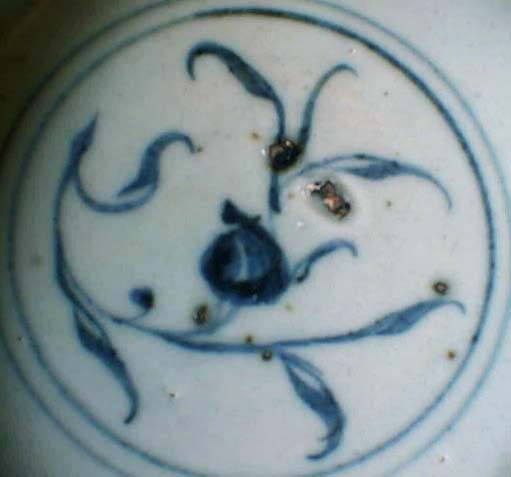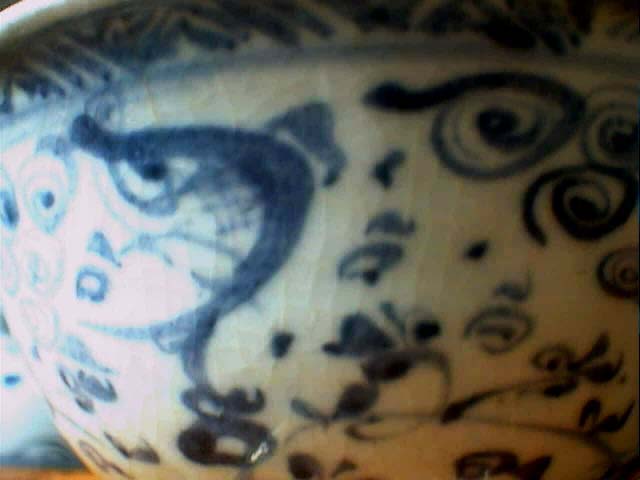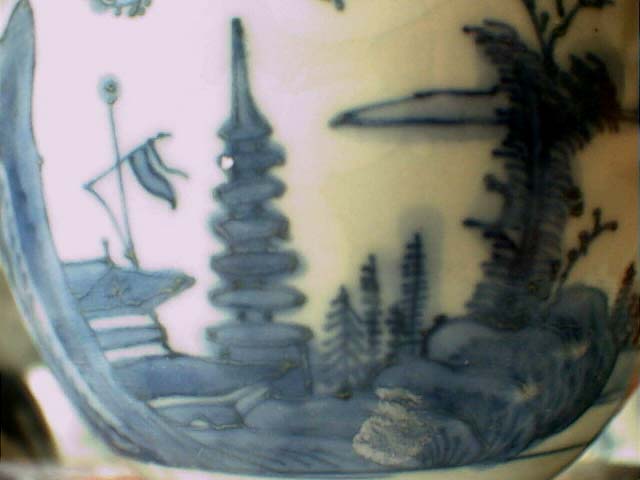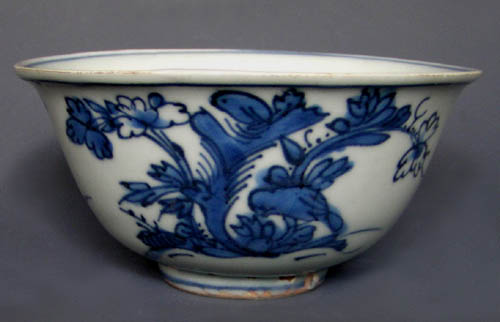 |
 |
|
Examples of Ming blue and white using calligraphic strokes |
|
Dating Ming Blue
and White
When dating a piece of Ming blue and white ware, it is necessary to adopt a holistic approach and consider the following 3 aspects:
Painting Techniques used:
Lines (Brush strokes)
Wash methods
Form/shape, glaze and cobalt
Type and evolution of motifs
The first two aspects would enable you to place the dating of a piece of Ming blue and white to one of the 3 phases, early (Hongwu to Tianshun), Mid (Chenghua to Zhengde) or late Ming (Jiajing to Chongzhen). To derive at an even more precise dating, we would need to examine the 3rd aspect.
Painting
Techniques
Lines (Brush Strokes)
The potters of the Early Ming period used calligraphic strokes to draw the motifs. To execute the strokes, the brush is held upright to write with its brush tip. By combining writing and stippling movements, brushstrokes are created which can be described as round, wet, soft, elastic and rhythmic. The lines shows variation in thickness. This style of brush strokes was used generally till the Zhengde period. There are still some from Jiajing or later which used such calligraphic strokes but could be singled out by after considering the additional dating guidelines.
 |
 |
|
Examples of Ming blue and white using calligraphic strokes |
|
From Jiajing period onward, the lines for the motif are generally executed in even thickness and appear stiffer when compared to the earlier period. The Chinese described it as iron-thread lines.
 |
|
|
Examples of Jiajing/Wanli motif using the iron-thread lines which shows thin and more uniform thickness lines |
|
Wash Methods
Before Tianshun period, motifs were depicted using calligraphic strokes. From around Tianshun period onward, the potters started to apply a wash of blue over part of the motif such as the flower or clothing of human figure. There are two wash methods:
Pigmented-Wash method
The pigmented-wash method was adopted by potters from Tianshun to Early Jiajing period. To create the wash, the potter press the tip of the colour brush and either stippled or swept gently at area to be coloured. The wash applied using this method has uneven tone of blue.
Waterdrop-wash method
The waterdrop wash method was most commonly used on blue and white from Late Wanli onward . The motif is outlined with even thickness iron-thread lines. The wash effect is created by dragging a pigmented water drop (suspended on the tip of the brush) across the area desired. This technique required great skill and creates an even coat of blue.
 |
 |
| Example from Hongzhi period using the pigmented wash | Example from Wanli using the waterdrop wash |
If the decoration used solely calligraphic strokes, the piece of blue and white is usually dated to before Tianshun period. From Tianshun to Zhengde, the decoration is executed using a combination of calligraphic strokes and pigmented wash method. Those from Late Jiajing onwards usually used the iron-thread outline and waterdrop wash method. For more examples, please click below link:
The guideline is applicable for most of the blue and white pieces. However, for pieces which were made during the duration when style changes, dating is more complicated. It is not unusual to find a dying style still used on small quantity of the production while a new style was developed and finally replaced the former. Despite the persistence of the older style of execution of the motif, other aspects will reveal its actual date of production. For example, the vessel is executed using calligraphic strokes. On first look, one would think it is dated to before Tianshun. However, the potting of the bowl is thin. This is a feature not found before Tianshun. Hence, we should look further and examine all other aspects to derive at the correct dating.
Form/shape, glaze and cobalt
Generally, the potting of Ming vessels is thick in the early Ming period and became increasingly thinner. This became very obvious from Jiajing period onward. For bowls, the wall of the footring is thick during the early Ming period and became typically thin from Jiajing period onward. One exception was some bowls with the Yu-bi type of broad footring wall found in Tingyi/Chongzhen. (see below photo). Large number of early Ming bowls also have unglazed outer base.

For type of bowls that could be found during the Ming period, please click below links:
Some other observations which are useful and help in dating includes:
The glaze of vessels before Jiajing is generally thicker and became thinner from Jiajing onward
Many early Ming vessels tend to be under fired and do not have a clear ring tone when tap.
During Jiajing period, a type of cobalt called Hui Qing was mixed with local cobalt to produce a purplish blue. It was used on some of the vessels from Jiajing to Tianqi period. Those made during the Wanli/Tianqi period, usually have a silvery grey tone to the cobalt blue.
Type and Evolution of Motifs
To progress beyond a broad Early Ming, Mid Ming or Late Ming categorisation, you would need to study the motifs and understand how they evolved over the Ming period. I have used motifs found in bowls for most of the illustrations but it is applicable also for other types of vessels.
Some of the popular motifs and how they evolved are illustrated below:
Evolution of motifs
Motif on Interior of bowl
Mark on outer base of bowl
Mark on outer base was not found on Mingyao blue and white bowls/plates before the Chenghua period. Some common marks found on Chenghua/Hongzhi bowls include fu (福), Tai Ping (太平), Da Ming Nianzao (大明年造) and etc. Please click below links for more details:
There are also those with reign marks and sometime undecipherable marks.
Decorative band near rim of bowl
Decorative band near the rim of a bowl is another source of information for dating. For example, those with Sanskrit/Tibetan characters band was common from Xuande to Zhengde, the chevron band was popular from Chenghua/Hongzhi pieces, key-fret common from Yongle to Chenghua, cross-hatched diaper from Xuande to early Wanli. Other decorative motifs were used but less frequently from Hongzhi onward. Over the whole of Ming period, there are bowl with no decorative band or just two parallel lines near the rim. Interestingly, from Late Jiajing onward, majority only has two parallel lines near the rim and without decoration on the inner wall of bowl.
Written by: NK Koh (5 Jun 2010)
| Be a sponsor and have access to additional information and reference materials on this site. To donate, click this link. |